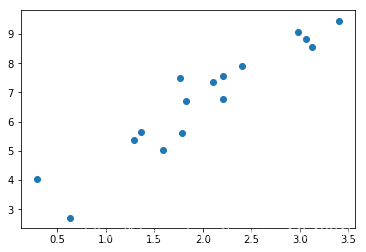实现线性回归
线性回归是机器学习入门知识,应用十分广泛。线性回归利用数理统计中回归分析,来确定两种或两种以上变量间相互依赖的定量关系的,其表达形式为
,
为误差服从均值为0的正态分布。首先让我们来确认线性回归的损失函数:
然后利用随机梯度下降法更新参数
和
来最小化损失函数,最终学得
和
的数值。
import torch as t
%matplotlib inline
from matplotlib import pyplot as plt
from IPython import display
device = t.device('cpu') #如果你想用gpu,改成t.device('cuda:0')
# 设置随机数种子,保证在不同电脑上运行时下面的输出一致
t.manual_seed(1000)
def get_fake_data(batch_size=8):
''' 产生随机数据:y=x*2+3,加上了一些噪声'''
x = t.rand(batch_size, 1, device=device) * 5
y = x * 2 + 3 + t.randn(batch_size, 1, device=device)
return x, y
# 来看看产生的x-y分布
x, y = get_fake_data(batch_size=16)
plt.scatter(x.squeeze().cpu().numpy(), y.squeeze().cpu().numpy())
<matplotlib.collections.PathCollection at 0x7fb5f2e5f780>

# 随机初始化参数
w = t.rand(1, 1).to(device)
b = t.zeros(1, 1).to(device)
lr =0.02 # 学习率
for ii in range(500):
x, y = get_fake_data(batch_size=4)
# forward:计算loss
y_pred = x.mm(w) + b.expand_as(y) # x@W等价于x.mm(w);for python3 only
loss = 0.5 * (y_pred - y) ** 2 # 均方误差
loss = loss.mean()
# backward:手动计算梯度
dloss = 1
dy_pred = dloss * (y_pred - y)
dw = x.t().mm(dy_pred)
db = dy_pred.sum()
# 更新参数
w.sub_(lr * dw)
b.sub_(lr * db)
if ii%50 ==0:
# 画图
display.clear_output(wait=True)
x = t.arange(0, 6).view(-1, 1)
y = x.mm(w) + b.expand_as(x)
plt.plot(x.cpu().numpy(), y.cpu().numpy()) # predicted
x2, y2 = get_fake_data(batch_size=32)
plt.scatter(x2.numpy(), y2.numpy()) # true data
plt.xlim(0, 5)
plt.ylim(0, 13)
plt.show()
plt.pause(0.5)
print('w: ', w.item(), 'b: ', b.item())

w: 1.9115010499954224 b: 3.044184446334839
w=2、b=3,图中直线和数据已经实现较好的拟合。